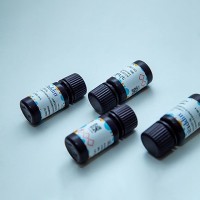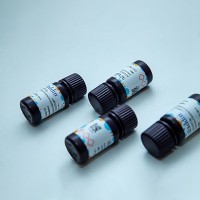Cell‐Based Hepatitis C Virus Infection Fluorescence Resonance Energy Transfer (FRET) Assay for Antiviral Compound Screening
互联网
- Abstract
- Table of Contents
- Materials
- Figures
- Literature Cited
Abstract
Hepatitis C virus (HCV) affects an estimated 3% of the population and is a leading cause of chronic liver disease worldwide. Since HCV therapeutic and preventative options are limited, the development of new HCV antivirals has become a global health care concern. This has spurred the development of cell?based infectious HCV high?throughput screening assays to test the ability of compounds to inhibit HCV infection. This unit describes methods that may be used to assess the in vitro efficacy of HCV antivirals using a cell?based high?throughput fluorescence resonance energy transfer (FRET) HCV infection screening assay, which allows for the identification of inhibitors that target HCV at any step in the viral life cycle. Basic protocols are provided for compound screening during HCV infection and analysis of compound efficacy using an HCV FRET assay. Support protocols are provided for propagation of infectious HCV and measurement of viral infectivity. Curr. Protoc. Microbiol. 18:17.5.1?17.5.27. © 2010 by John Wiley & Sons, Inc.
Keywords: hepatitis C virus; viral lifecycle; Huh7 cells; dimethylsulfoxide (DMSO); fluorescence resonance energy transfer (FRET); NS3 protease; antivirals; high?throughput screening
Table of Contents
- Introduction
- Basic Protocol 1: Screening of Anti‐HCV Compounds in Hepatoma Cells
- Basic Protocol 2: Quantification of HCV Infection Using a Cell‐Based NS3 Protease Assay
- Support Protocol 1: Generation of HCVcc from In Vitro–Transcribed RNA
- Support Protocol 2: Generation of HCVcc from Infectious Virus
- Support Protocol 3: HCVcc Infectivity Titer Analysis
- Reagents and Solutions
- Commentary
- Literature Cited
- Figures
- Tables
Materials
Basic Protocol 1: Screening of Anti‐HCV Compounds in Hepatoma Cells
Materials
Basic Protocol 2: Quantification of HCV Infection Using a Cell‐Based NS3 Protease Assay
Materials
Support Protocol 1: Generation of HCVcc from In Vitro–Transcribed RNA
Materials
Support Protocol 2: Generation of HCVcc from Infectious Virus
Materials
Support Protocol 3: HCVcc Infectivity Titer Analysis
Materials
|
Figures
-
Figure 17.5.1 Sample plate layout for HTS anti‐HCV compound screening. This illustrates a standard plate layout in which two columns have been reserved for controls. However, compound libraries are often provided with only one empty column for the addition of controls. The layout chosen for individual screening campaigns will need to be adapted to accommodate these restrictions, and, if necessary, to avoid areas prone to “edge effect.” View Image -
Figure 17.5.2 NS3 FRET peptide substrate. (A ) The 5‐FAM/QXL 520 NS3 FRET substrate is an internally quenched peptide with a fluorescent donor (5‐FAM) and acceptor (QXL) on opposing sides of the NS3 protease cleavage site. (B ) FRET protease assay. The donor absorbs energy at 490 nm and emits energy (i.e., fluorescence) at 520 nm. However, when in close contact on an intact peptide, the acceptor absorbs the 520‐nM energy emitted by the donor, preventing fluorescence. Cleavage of the peptide increases the distance between the fluorophores, resulting in proportional 5‐FAM fluorescence. Diagram and figure adapted from AnaSpec product information (http://www.anaspec.com/products/product.asp?id=30173&productid=13982). View Image -
Figure 17.5.3 Sample plate layout for virus titration. 24 viral serial dilutions can be conveniently performed in each U‐bottom 96‐well microtiter plate. In this example, the wells in rows 1 and 5 are filled with the individual virus samples to be analyzed while the wells in rows 2 to 4 and 6 to 8 are each filled with 180 µl of Huh7 cell maintenance medium. Using a multichannel pipettor, three 1:10 dilutions can be made by transferring 20 µl between wells down each column, beginning with the undiluted virus row and moving on to the 1:10 row, the 1:100 row, and the 1:1000 row. It is important to thoroughly mix the virus dilution by pipetting up and down after each transfer, and to change pipet tips between each transfer. View Image
Videos
Literature Cited
| Literature Cited | |
| Alter, H.J. and Seeff, L.B. 2000. Recovery, persistence, and sequelae in hepatitis C virus infection: A perspective on long‐term outcome. Semin. Liver Dis. 20:17‐35. | |
| Bianchi, E., Steinkuhler, C., Taliani, M., Urbani, A., Francesco, R.D., and Pessi, A. 1996. Synthetic depsipeptide substrates for the assay of human hepatitis C virus protease. Anal. Biochem. 237:239‐244. | |
| Brown, T., Mackey, K., and Du, T. 2004. Analysis of RNA by northern and slot blot hybridization. Curr. Protoc. Mol. Biol. 67: 4.9.1‐4.9.19. | |
| Choi, S., Sainz, B., Jr., Corcoran, P., Uprichard, S., and Jeong, H. 2009. Characterization of increased drug metabolism activity in dimethyl sulfoxide (DMSO)‐treated Huh7 hepatoma cells. Xenobiotica 39:205‐217. | |
| Chomczynski, P. and Sacchi, N. 1987. Single‐step method of RNA isolation by acid guanidinium thiocyanate‐phenol‐chloroform extraction. AnalBiochem 162:156‐159. | |
| Condit, R. 2007. Principles of virology. In Field's Virology (B. Fields, D. Knipe, P. Howley, and D. Griffin, eds.) pp. 25‐55. Lippincott Williams & Wilkins, Philadelphia. | |
| Cooper, P.D. 1967. The plaque assay of animal viruses. In Methods in Virology (K. Maramorosch, K. and H. Koprowski, eds.) pp. 243‐311. Academic Press, New York London. | |
| Diaz‐Ruiz, J. R. and Kaper, J. M. 1978. Isolation of viral double‐stranded RNAs using a LiCl fractionation procedure. Prep. Biochem. 8:1‐17. | |
| Gallagher, S.R. and Desjardins, P.R. 2006. Quantitation of DNA and RNA by absorption and fluorescence spectroscopy. Curr. Protoc. Mol. Biol. 76:A.3D.1‐A.3D.21. | |
| Glue, P., Fang, J.W., Rouzier‐Panis, R., Raffanel, C., Sabo, R., Gupta, S.K., Salfi, M., and Jacobs, S. 2000. Pegylated interferon‐alpha2b: Pharmacokinetics, pharmacodynamics, safety, and preliminary efficacy data. Hepatitis C Intervention Therapy Group. Clin. Pharmacol. Ther. 68:556‐567. | |
| Gosert, R., Egger, D., Lohmann, V., Bartenschlager, R., Blum, H.E., Bienz, K., and Moradpour, D. 2003. Identification of the hepatitis C virus RNA replication complex in Huh‐7 cells harboring subgenomic replicons. J. Virol. 77:5487‐5492. | |
| Kakiuchi, N., Nishikawa, S., Hattori, M., and Shimotohno, K. 1999. A high throughput assay of the hepatitis C virus nonstructural protein 3 serine proteinase. J. Virol. Methods 80:77‐84. | |
| Kato, T., Furusaka, A., Miyamoto, M., Date, T., Yasui, K., Hiramoto, J., Nagayama, K., Tanaka, T., and Wakita, T. 2001. Sequence analysis of hepatitis C virus isolated from a fulminant hepatitis patient. J. Med. Virol. 64:334‐339. | |
| Kato, T., Date, T., Miyamoto, M., Furusaka, A., Tokushige, K., Mizokami, M., and Wakita, T. 2003. Efficient replication of the genotype 2a hepatitis C virus subgenomic replicon. Gastroenterology 125:1808‐1817. | |
| Kingston, R., Chomczynski, P., and Sacchi, N. 1996. Guanidine methods for total RNA preparation. Curr. Protoc. Mol. Biol. 36:4.2.1‐4.2.9. | |
| Law, M., Maruyama, T., Lewis, J., Giang, E., Tarr, A.W., Stamataki, Z., Gastaminza, P., Chisari, F.V., Jones, I.M., Fox, R.I., Ball, J.K., McKeating, J.A., Kneteman, N.M., and Burton, D.R. 2008. Broadly neutralizing antibodies protect against hepatitis C virus quasispecies challenge. Nat. Med. 14:25‐27. | |
| Lindenbach, B.D. and Rice, C.M. 2005. Unravelling hepatitis C virus replication from genome to function. Nature 436:933‐938. | |
| Lindenbach, B.D., Evans, M.J., Syder, A.J., Wölk, B., Tellinghuisen, T.L., Liu, C.C., Maruyama, T., Hynes, R.O., Burton, D.R., McKeating, J.A., and Rice, C.M. 2005. Complete replication of hepatitis C virus in cell culture. Science 309:623‐626. | |
| Nakabayashi, H., Taketa, K., Miyano, K., Yamane, T., and Sato, J. 1982. Growth of human hepatoma cells lines with differentiated functions in chemically defined medium. Cancer Res. 42:3858‐3863. | |
| Nelson, H. B. and Tang, H. 2006. Effect of cell growth on hepatitis C virus (HCV) replication and a mechanism of cell confluence‐based inhibition of HCV RNA and protein expression. J. Virol. 80:1181‐1190. | |
| O'Boyle, D.R. 2nd, Nower, P.T., Lemm, J.A., Valeras, L., Sun, J.H., Rigat, K., Colonno, R., and Gao, M. 2005. Development of a cell‐based high‐throughput specificity screen using a hepatitis C virus‐bovine viral diarrhea virus dual replicon assay. Antimicrob. Agents Chemother. 49:1346‐1353. | |
| Phelan, M. 2007. Basic techniques in mammalian cell culture. Curr. Protoc. Cell Biol. 36:1.1.1‐1.1.18. | |
| Pietschmann, T., Lohmann, V., Rutter, G., Kurpanek, K., and Bartenschlager, R. 2001. Characterization of cell lines carrying self‐replicating hepatitis C virus RNAs. J. Virol. 75:1252‐1264. | |
| Reed, L.J. and Muench, H. 1938. A simple method of estimating fifty percent endpoints. Am. J. Hyg. 27:493. | |
| Sainz, B. Jr. and Chisari, F.V. 2006. Production of infectious hepatitis C virus by well‐differentiated, growth‐arrested human hepatoma‐derived cells. J. Virol. 80:10253‐10257. | |
| Sainz, B. Jr., Barretto, N., and Uprichard, S.L. 2009. Hepatitis C virus infection in phenotypically distinct Huh7 cell lines. PLoS ONE 4:e6561. | |
| Taliani, M., Bianchi, E., Narjes, F., Fossatelli, M., Urbani, A., Steinkühler, C., De Francesco, R., and Pessi, A. 1996. A continuous assay of hepatitis C virus protease based on resonance energy transfer depsipeptide substrates. Anal. Biochem. 240:60‐67. | |
| Wakita, T., Pietschmann, T., Kato, T., Date, T., Miyamoto, M., Zhao, Z., Murthy, K., Habermann, A., Kräusslich, H.G., Mizokami, M., Bartenschlager, R., and Liang, T.J. 2005. Production of infectious hepatitis C virus in tissue culture from a cloned viral genome. Nat. Med. 11:791‐796. | |
| Williams, R. 2006. Global challenges in liver disease. Hepatology 44:521‐526. | |
| Windisch, M.P., Frese, M., Kaul, A., Trippler, M., Lohmann, V., and Bartenschlager, R. 2005. Dissecting the interferon‐induced inhibition of hepatitis C virus replication by using a novel host cell line. J. Virol. 79:13778‐13793. | |
| Yu, X., Sainz, B. Jr. and Uprichard, S.L. 2009. Development of a cell‐based hepatitis C virus infection fluorescent resonance energy transfer assay for high‐throughput antiviral compound screening. Antimicrob. Agents Chemother. 53:4311‐4319. | |
| Zhang, J.H., Chung, T.D., and Oldenburg, K.R. 1999. A simple statistical parameter for use in evaluation and validation of high throughput screening assays. J. Biomol. Screen. 4:67‐73. | |
| Zhong, J., Gastaminza, P., Cheng, G., Kapadia, S., Kato, T., Burton, D.R., Wieland, S.F., Uprichard, S.L., Wakita, T., and Chisari, F.V. 2005. Robust hepatitis C virus infection in vitro. Proc. Natl. Acad. Sci. U.S.A. 102:9294‐9299. | |
| Zhong, J., Gastaminza, P., Chung, J., Stamataki, Z., Isogawa, M., Cheng, G., McKeating, J.A., and Chisari, F.V. 2006. Persistent hepatitis C virus infection in vitro: coevolution of virus and host. J. Virol. 80:11082‐11093. |






